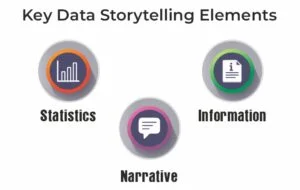Organizations are producing more data than ever before as the digital realm keeps growing. Although communicating a large volume of data is valuable, it does not initiate action or aid in making significant decisions.
To contextualize meaning and impact with a narrative that transcends numerical statistics, it is essential to recognize data as a story. How does this operate?
AI data storytelling is changing the way teams and executives gain insights. Considering the outstanding growth of AI and high volumes of data generated, companies are starting to rethink storytelling to connect analytics to decision-making. No matter the size of the issue, leaders may use data stories to link impacts and tales to get in action.
Users can more quickly and effectively transform raw data points into personalized stories using generative artificial intelligence and data visualization. What are the key components, possible obstacles, and fundamental methods for comprehending AI storytelling?
Let’s understand this blog! Without any further ado, we’ll begin!
What Is Data Storytelling?
Data storytelling is mainly the process of using data, visuals, and narrative to convey a meaningful message. Instead of displaying spreadsheets or static dashboards, the focus is on connecting facts to people in meaningful ways that connect them intellectually and emotionally.
A good data story should include three elements:
Statistics: Reliable, pertinent, and extensively studied data that provides key information.
Narrative: A structured and captivating narrative that elucidates the significance of the information.
Information: Graphics, charts, infographics, and interactive visualizations of insights that make them easy to understand.
By combining the relevant elements, decision-makers can comprehend context, grasp its significance, and feel empowered to act.
How Does AI Help with Storytelling?
While conventional data storytelling has been a long-standing skill, AI’s capabilities have made it an entirely new skill to learn. AI-generated storytelling tools simplify data analysis, reduce human bias, and reveal connections.
Automating Insights Generation
Humans stay behind when it comes to speed. On the other hand, AI algorithms can analyze large volumes of datasets, identify patterns, and do so more quickly.
Narrative Personalization
AI is here to transform the complete scenario of storytelling. It can curate tailored narratives according to the particular choices and preferences. For instance, a CEO might be seeking actionable insights. Or a marketing team wants some effective campaigns that can elevate the business game.
Dynamic Data Visualization
Automated visuals that are powered by artificial intelligence (AI) will adjust to show the strongest patterns. The aim is to present intricate information in a manner that resonates with stakeholders who are not technical. This is important.
Enhanced Relevance and Accessibility
The use of AI-driven storytelling facilitates accessibility to insights. What was once the domain of data scientists is now easily understood by marketing leaders, salespeople, and even external partners.
Benefits of AI-Powered Data Storytelling
Organizations that use AI for storytelling gain significant benefits:
Rapid analysis and reporting lead to faster insight: The gap between discovery and decision is reduced. Why?
Scalability is key: as AI can create stories that span different departments and functions without manual interpretation.
More Reliability: AI reduces human error and bias to deliver more accurate stories.
Character development: Narratives develop to become more interactive, relatable, and in line with the audience’s tastes.
The ability to make informed decisions with greater confidence can be attributed to actionability.
Challenges in Data Storytelling.
The potential of data storytelling is not without its challenges:
Inaccuracy: Authors and writers may unknowingly manipulate data to reinforce a particular story.
Inability to Change: Some leaders may resist narratives that challenge their assumptions or long-held beliefs.
How to Cope Up with These Challenges
- Make sure to use the right AI verification tools to avoid further mishaps.
- Maintain transparency. Do not keep the data sources or methodologies used in storytelling hidden.
- Encourage an environment where teams are challenged in an open manner and value insights derived from data.
AI-Powered Data Storytelling Techniques
Organizations can use these AI-enabled methods to enhance their data storytelling:
Narrative Generation with AI
Focus on using natural language generation tools to create narratives directly from the data.
Interactive Dashboards with AI Insights
Do not depend completely on the static charts. Start using AI-generated dashboards that offer effective results.
Personalized Storytelling
Depending on the unique conditions of each audience, such as executives and investors, Gen AI can provide multiple versions of a story.
Predictive Storytelling
Use predictive analytics to tell you about both past performance and future outcomes through storytelling.
The Future of Data Storytelling
With the development of AI and data reporting tools, the future of data storytelling is rich, interactive, and personal. The leader’s shift to real-time storytelling involves breaking away from the dashboard and utilizing predictive and even generative AI.
Ultimately, however, it’s not just about storytelling; it’s also about how AI gets its data: the stories that drive those decisions and then action and eventually lead to tangible business outcomes.
Storytelling is crucial in ensuring that insights are not just passive but also impact the future!
Check out our blog section for the latest updates on informative content!
Recommended For You:
Are Generative AI Models Becoming Commodities or a Core Business Differentiator?
What Are Some Ethical Considerations When Using Generative AI?


